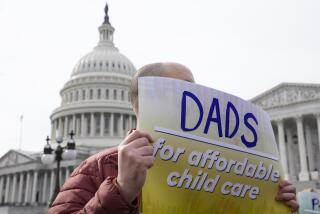Wilson Proposes $300 Million More for State Child Care
- Share via
SACRAMENTO — Gov. Pete Wilson proposed Monday adding nearly $300 million to the state’s child care system, more than quadrupling a recent proposal from Democrats and substantially changing the state’s debate about welfare reform.
Wilson aides are confident that public opinion will support the demanding work schedules they want to impose on adult welfare recipients if the rules are not harmful to children.
Before the governor’s announcement, Democrats were poised to use the threat to children as a major weapon in attacking Wilson’s plan as being too harsh. Now, Wilson’s funding plan has either taken the issue off the table or--at least--significantly quelled the debate for the upcoming budget.
“This particular new idea from the governor is one that we strongly support,” said state Senate President Pro Tem Bill Lockyer (D-Hayward). “To make welfare policy work, you have got to help get people get to jobs. That means child care.”
Wilson’s plan for child care funding was in a package of welfare proposals the governor rolled out Monday--all financed by an unexpected budget windfall the state is enjoying because of a surging economy.
The package--worth a total of about $440 million in new funds--was recommended to the governor in a report released Monday by a task force of business representatives assigned to study welfare reform.
In addition to child care, Wilson said he would fund the group’s call for more job training and a new statewide computer system that would match job openings to job seekers.
Wilson’s plan would add $95 million more for welfare job training, about two-thirds of what Democratic leaders recommended last week. The computer system--which would utilize a World Wide Web page on the Internet as a clearinghouse to match employers and job applicants--was funded at about $18 million.
“There are few greater or more important challenges than helping our fellow Californians make a successful transition from welfare to work,” said Wilson, who was flanked by task force members at an afternoon news conference in his Capitol office. “That’s why . . . I directed two dozen of California’s business leaders to take an honest, hard look at the challenges presented by welfare reform.”
By far the most significant issue in Wilson’s plan is the funding for child care. Wilson’s call for $278 million in new funds is more than quadruple the $61-million increase Democrats recommended last week.
The governor’s addition raised his total budget proposal for child care to about $1.3 billion in state and federal funds.
On Monday, Democratic leaders said they were unaware how much surplus money was available to spend. They also said they are uncertain how fast the state can spend the money because the capacity of the child care system will need to be expanded.
Wilson officials said the new funding is enough to pay for about 430,000 subsidized child care slots, up from about 275,000 children now being served.
Even that level of care cannot accommodate the 1.8 million children now living in welfare families where parents could be forced into the workplace.
But Wilson officials said the scope of their plan should more than cover the families who are able to make the transition off welfare in the upcoming fiscal year.
If more child care is needed, Wilson said, it will mean that the state is exceeding its welfare goals and would therefore have additional savings that he would direct to even more child care.
Democrats and child care advocates, although happy with the governor’s allocation Monday, predicted that much more money would be needed in future years to provide quality care for welfare children.
Assemblywoman Dion Aroner (D-Berkeley), a co-chairwoman of the Legislature’s special committee on welfare reform, said the long-term cost could be as high as $5 billion.
“The governor’s investment gets us further and it may be the appropriate level for the upcoming year,” she said. “I think about $5 billion is what we need [eventually] . . . to put that issue to bed.”
Aroner said the governor’s announcement might quell the Capitol debate about how much money should be dedicated to child care this year. But she said serious questions remain about standards for quality and the administration of the programs.
Democrats differ with Wilson, for example, on the age when infants are ready for child care. Wilson wants welfare parents to work when their child is 12 weeks old. Democrats would wait for one year.
There is also a rivalry over the administration of child care between the state departments of education and social services.
Democrats generally favor the Education Department because of its focus of treating child care as an extension of the school curriculum.
In contrast, critics complain that the highest priority of the Social Services Department is to move welfare adults into the work force, possibly leaving the quality of child care as an afterthought.
Wilson’s proposal would assign the new funds to the Social Services Department at about $3,000 per child per year, down from about $3,200 under existing programs.
That is below the state’s average market value for child care, advocates said. But they stopped short of saying the care at that price would be inadequate.
“That’s cutting it real close,” said Alice Walker Duff, director of a nonprofit child care organization in Los Angeles and vice president of the California Child Care Resource and Referral Network.
“It is a beginning,” she said. “It is critical that the money be spent in a way that has what we call a two-generation focus. That is, while parents are earning money, children are learning so when they grow up they can earn money.”
Patty Siegel, executive director of the resource and referral network, also said the “devil is in the details.” But if the money is spent correctly, she said, it will be adequate.
“It is not just a question of having money to pay for child care but also having money to build the capacity of the system,” she said. “It sounds to me like this ought to be enough money to do both of those. So it is a welcome addition.”
The common ground on child care should focus more attention on the remaining differences between Wilson and Democratic leaders about welfare.
The sharpest difference remaining is a philosophical split about the best methods for the government to shape behavior--with a stick or a carrot.
Wilson would force new welfare recipients off welfare in one year and require that they work up to 35 hours per week while they are receiving assistance. The governor believes that the threat of homelessness or other tragedies is an essential motivation to force people off welfare.
Democrats would provide far more assistance in preparing the recipient for the work force. They would provide three to five years of aid, depending on a person’s need for training or other services such as drug rehabilitation.
One subtle effect of Wilson’s child care allocation was to leave Democrats with less money to spend on the job training programs that the governor opposes.
But Lockyer said that will not be a problem. He said Democrats could find the money by killing the governor’s proposal for a 5% tax cut for banks and corporations.
(BEGIN TEXT OF INFOBOX / INFOGRAPHIC)
Child Care Funding (Southland Edition, A1)
THE PROBLEM:
* New federal legislation will require welfare parents to work, forcing states to dramatically expand their child care systems.
POTENTIAL IMPACT:
* State officials are unsure how much more child care will be needed, but 1.8 million children are now living in welfare families.
California children now receiving subsidized care: 275,000
Governor’s estimate for 1997-98: 430,000
MONDAY’S PROPOSAL:
* Gov. Pete Wilson would add $278 million to his 1997-98 budget allocation for the state’s child care system. This far exceeds the $61 million in additional funding proposed last week by Democrats.
Source: Governor’s office
More to Read
Get the L.A. Times Politics newsletter
Deeply reported insights into legislation, politics and policy from Sacramento, Washington and beyond. In your inbox twice per week.
You may occasionally receive promotional content from the Los Angeles Times.










